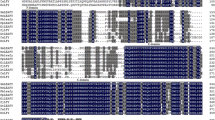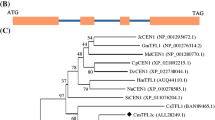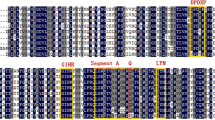Abstract
Hickory (Carya cathayensis Sarg.) is an important economic nut tree in China. However, its long juvenile phase is a deterrent to expanding its cultivation and production to wider areas. To understand the genetic and molecular mechanisms that underlie the reproductive process in hickory trees, CcLFY, a homologue of FLORICAULA/LEAFY, was cloned and its expression patterns were studied during vegetative and reproductive development. The cDNA sequence of CcLFY consisted of 1,442 bp encoding a putative protein of 385 amino acids. The protein consisted of a Pro-rich region, a central acidic domain, a putative Leucine zipper, and a basic region formed by a core of Arg and Lys residues that are critical motifs for transcription factors. sThe amino acid sequence of the CcLFY protein shares 89.2% and 65.6% identities with LFY proteins of Castanea mollissima and Arabidopsis thaliana, respectively. CcLFY was highly expressed in flower buds and leaves, weakly expressed in stems, and was undetectable in roots. In situ hybridization revealed that CcLFY was highly expressed in both immature leaves and flower buds. Expression of CcLFY was initiated during floral transition in the spring, and subsequently, continued to increase, reaching peak levels at 16 days after full bloom (DAFB). Moreover, during this period, the major floral buds formed. Heterologous expression of CcLFY in transgenic tobacco plants induced precocious flowering of growing shoots, and flowers were of normal phenotypes. These results suggested that CcLFY might play a pivotal role in flower initiation and in the development of floral organs in C. cathayensis.











Similar content being viewed by others
References
Ahearn KP, Johnson HA, Weigel D, Wagner DR (2001) NFL1, a Nicotiana tabacum LEAFY-like gene, controls meristem initiation and floral structure. Plant Cell Physiol 42:1130–1139
Altschul J, Madden TL, Schffer AA, Zhang J, Zhang Z, Miler W, Lipman DJ (1997) Gapped BLAST and PSI-BLAST: a new generation of protein database search programs. Nucleic Acids Res 25:3389–3402
Blázquez MA, Soowal LN, Lee I, Weigel D (1997) LEAFY expression and flower initiation in Arabidopsis. Development 124:3835–3844
Bomblies K, Wang RL, Ambrose BA, Schmidt RJ, Meeley RB, Doebley J (2003) Duplicate FLORICAULA/LEAFY homologs zfl1 and zfl2 control inflorescence architecture and flower patterning in maize. Development 130:2385–2395
Bradley D, Carpenter R, Copsey L, Vincent C, Rothstein S, Coen ES (1996) Control of inflorescence architecture in Antirrhinum. Nature 379:791–797
Bustin SA, Beaulieu JF, Hugget J, Jaggi R, Kibenge FSB, Olsvik PA, Penning LC, Toegel S (2010) MIQE precis: practical implementation of minimum standard guidelines for fluorescence-based quantitative real-time PCR experiments. BMC Mol Biol 11:74–78
Carmona MJ, Cubas P, Martinez-Zapater JM (2002) VFL, the grapevine FLORICAULA/LEAFY ortholog, is expressed in meristematic regions independently of their fate. Plant Physiol 130:68–77
Chang L, Wu L, Chen Y, Ku L, Yang S, Zhang S, Wang X, Wei X (2011) Expression and functional analysis of the ZCN1 (ZmTFL1) gene, a TERMINAL FLOWER 1 homologue that regulates the vegetative to reproductive transition in maize. Plant Mol Biol Rep. doi:10.1007/s11105-011-0317-2
Coen ES, Romero JM, Elliot R (1990) FLORICAULA: a homeotic gene required for flower development in Antirrhinum majus. Cell 63:1311–1322
Dornelas MC, Rodriguez APM (2005a) A FLORICAULA/LEAFY gene homolog is preferentially expressed in developing female cones of the tropical pine Pinus caribaea var caribaea. Gen Mol Biol 28:299–307
Dornelas MC, Rodriguez APM (2005b) The rubber tree (Hevea brasiliensis MuellArg) homologue of the LEAFY/FLORICAULA gene is preferentially expressed in both male and female floral meristems. J Exp Bot 56:1965–1974
Dornelas MC, Rodriguez APM (2006) The tropical cedar tree (Cedrela fissilis Vell, Meliaceae) homolog of the Arabidopsis LEAFY gene is expressed in reproductive tissues and can complement Arabidopsis leafy mutants. Planta 223:306–314
Dornelas MC, Wittich PE, von Recklinghausen IR, van Lammeren AAM, Kreis M (1999) Characterization of three novel members of the Arabidopsis SHAGGY-related protein kinases (ASK) multigene family. Plant Mol Biol 39:137–147
Dornelas MC, Van Lammeren AA, Kreis M (2000) Arabidopsis thaliana SHAGGY-related protein kinases (AtSK11 and 12) function in perianth and gynoecium development. Plant J 21:419–429
Dornelas MC, Amaral WN, Rodriguez APM (2004) EgLFY, the Eucalyptus grandis homolog of the Arabidopsis gene LEAFY is expressed in reproductive and vegetative tissues. Braz J Plant Physiol 16:105–114
Du N, Pijut PM (2010) Isolation and characterization of an AGAMOUS homolog from Fraxinus pennsylvanica. Plant Mol Biol Rep 28:344–351
Frohlich MW, Estabrook GF (2000) Wilkinson support calculated with exact probabilities: an example using Floricaula/LEAFY amino acid sequences that compares three hypotheses involving gene gain/loss in seed plants. Mol Biol Evol 17:1914–1925
Hamès C, Ptchelkine D, Grimm C, Thevenon E, Moyroud E, Gérard F, Martiel JL, Benlloch R, Parcy F, Müller CW (2008) Structural basis for LEAFY floral switch function and similarity with helix-turn-helix proteins. EMBO J 27:2628–2637
Hou JH, Gao ZH, Zhang Z, Chen SM, Ando T, Zhang JY, Wang XW (2011) Isolation and characterization of an AGAMOUS homologue PmAG from the Japanese apricot (Prunus mume Sieb. et Zucc.). Plant Mol Biol Rep 29:473–480
Huang Y, Xia G, Wang Z, Zheng B, Liang J, Huang J (2007) Studies on anatomy of development of female flower in Carya cathayensis Sarg. Acta Agriculturae Universitatis Jiangxiensis 29(5):723–726
Kelly AJ, Bonnlander MB, Meeks-Wagner DR (1995) NFL, the tobacco homolog of FLORICAULA and LEAFY, is transcriptionally expressed in both vegetative and floral meristems. Plant Cell 7:225–234
Kyozuka J, Konishi S, Nemoto K, Izawa T, Shimamoto K (1998) Down-regulation of RFL, the FLO/LFY homolog of rice, accompanied with panicle branch initiation. Proc Natl Acad Sci USA 95(5):1979–1982
Lee J, Lee I (2010) Regulation and function of SOC1, a flowering pathway integrator. J Exp Bot 61:2247–2254
Lee I, Wolfe DS, Nilsson O, Weigel D (1997) A LEAFY co-regulator encoded by UNUSUAL FLORAL ORGANS. Curr Biol 7(2):95–104
Li H, Liu F, Liu G, Wang S, Guo X, Jing J (2011) Molecular cloning and expression analysis of 13 MADS-Box genes in Betula platyphylla. Plant Mol Biol Rep. doi:10.1007/s11105-011-0326-1
Liu C, Thong Z, Yu H (2009) Coming into bloom: the specification of floral meristems. Development 136:3379–3391
Liu X, Anderson JM, Pijut PM (2010) Cloning and characterization of Prunus serotina AGAMOUS, a putative flower homeotic gene. Plant Mol Biol Rep 28:193–203
Livak KJ, Schmittgen TD (2001) Analysis of relative gene expression data using real-time quantitative PCR and the 2−ΔΔCT method. Methods 25:402–408
Lohmann JU, Weigel D (2002) Building beauty: the genetic control of floral patterning. Dev Cell 2:135–142
Ma G, Ning G, Zhang W, Zhan J, Lv H, Bao M (2011) Overexpression of Petunia SOC1-like gene FBP21 in tobacco promotes flowering without decreasing flower or fruit quantity. Plant Mol Biol Rep 29:573–581
Maizel A, Busch MA, Tanahashi T, Perkovic J, Kato M, Hasebe M, Weigel D (2005) The floral regulator LEAFY evolves by substitutions in the DNA binding domain. Science 308:260–263
Mellerowicz EJ, Horgan K, Walden A, Coker A, Walter C (1998) PRFLL—a Pinus radiata homologue of FLORICAULA and LEAFY is expressed in buds containing vegetative shoot and undifferentiated male cone primordia. Planta 206:619–629
Moon J, Lee H, Kim M, Lee I (2005) Analysis of flowering pathway integrators in Arabidopsis. Plant Cell Physiol 46:292–299
Mouradov A, Glassic T, Hamdorf B, Murphy L, Fowler B, Marla S, Teasdale RD (1998) NEEDLY, a Pinus radiata ortholog of FLORICAULA/LEAFY genes, expressed in both reproductive and vegetative meristems. Proc Natl Acad Sci USA 95:6537–6542
Mouradov A, Cremer F, Coupland G (2002) Control of flowering time: interacting pathways as a basis for diversity. Plant Cell 14:S111–S130
Moyroud E, Tichtinsky G, Parcy F (2009) The LEAFY floral regulators in Angiosperms: conserved proteins with diverse roles. J Plant Biol 52:177–185
Moyroud E, Kusters E, Monniaux M, Koes R, Parcy F (2010) LEAFY blossoms. Trends Plant Sci 15:346–352
Peña L, Martin-Trillo M, Juárez J, Pina JA, Navarro L, Martínez-Zapater JM (2001) Constitutive expression of Arabidopsis LEAFY or APETALA1 genes in citrus reduces their generation time. Nat Biotechnol 19:263–267
Rottmann WH, Meilan R, Sheppard LA, Brunner AM, Skinner JS, Ma C, Cheng S, Jouanin L, Pilate G, Strauss SH (2000) Diverse effects of over-expression of LEAFY and PTLF, a poplar (Populus) homolog of LEAFY/FLORICAULA, in transgenic poplar and Arabidopsis. Plant J 22:235–245
Sambrook J, Fritsch FP, Maniatis T (1989) Molecular cloning. Cold Spring Harbor Laboratory Press, Cold Spring Harbor, NY
Shiokawa T, Yamada S, Futamura N, Osani K, Murasugi D, Shinohara K, Kawai S, Morohoshi N, Katayama Y, Kajita S (2008) Isolation and functional analysis of the CjNdly gene, a homolog in Cryptomeria japonica of FLORICAULA/LEAFY genes. Tree Physiol 28:21–28
Simpson GG, Dean C (2002) Arabidopsis, the Rosetta stone of flowering time? Science 296:285–289
Souer E, Vander K, Kloos D, Spelt C, Bliek M (1998) Genetic control of branching pattern and floral identity during Petunia inflorescence development. Development 125:733–742
Southerton SG, Marshall H, Mouradov A (1998) Eucalyptus MADS-box genes expressed in developing flowers. Plant Physiol 118:365–372
Tai TH, Tanksley SD (1990) A rapid and inexpensive method for isolation of total DNA from dehydrated plant tissue. Plant Mol Biol Rep 8:297–303
Taiz L, Zeiger E (2006) Plant physiology, 4th edn. Sinauer Associates Inc., Sunderland MA
Thompson JD, Higgins DG, Gibson TJ (1994) CLUSTAL W: improving the sensitivity of progressive multiple sequence alignment through sequence weighting, positions-specific gap penalties and weight matrix choice. Nucleic Acids Res 22:4673–4680
Wada M, Cao QF, Kotoda N, Soejima J, Masuda T (2002) Apple has two orthologues of FLORICAULA/LEAFY involved in flowering. Plant Mol Bio 49:567–577
Walton EF, Podivinsky E, Wu RM (2001) Bimodal pattern of floral gene expression over the two seasons that kiwifruit flowers develop. Physiol Plant 111:396–404
Wang SX, Hunter W, Plant A (2000) Isolation and purification of functional total RNA from woody branches and needles of Sitka and white spruce. Biotechniques 28:292–296
Weigel D, Nilsson O (1995) A developmental switch sufficient for flower initiation in diverse plants. Nature 377:495–500
Weigel D, Alvarez J, Smyth DR, Yanofsky MF, Meyerowitz FM (1992) LEAFY controls floral meristem identity in Arabidopsis. Cell 4:910–913
Xu J, Zhong X, Zhang Q, Li H (2010) Overexpression of the GmGAL2 gene accelerates flowering in Arabidopsis. Plant Mol Biol Rep 28:704–711
Yamada S, Kajita S, Shiokawa T, Morohoshi N (2003) Isolation and functional analysis of the promoter sequence of the Cryj1 gene, which encodes a major allergenic protein in the pollen of Japanese cedar (Cryptomeria japonica). Plant Biotechnol 20:241–245
Zhang A, Qiu L, Huang L, Yu X, Lu G, Cao J (2011) Isolation and characterization of an anther-specific polygalacturonase gene, BcMF16, in Brassica campestris ssp. chinensis. Plant Mol Biol Rep 2011. doi:10.1007/s11105-011-0341-2
Zheng BS, Chu HL, Jin SH, Huang YJ, Wang ZJ, Chen M, Huang JQ (2010) cDNA-AFLP analysis of gene expression in hickory (Carya cathayensis) during graft process. Tree Physiol 30:297–303
Acknowledgements
This work was supported by the National Natural Science Foundation of China (30872047, 31170637 and 31070604), the initial project of the National Basic Research Program of China (2011CB111510), the Zhejiang Provincial Natural Science Foundation of China (Z307534 and Y305331), the Key Project of the Department of Science and Technology of Zhejiang Province (2007C12023) and the Innovation Team Project of Zhejiang A & F University (Class B) (2007).
Author information
Authors and Affiliations
Corresponding author
Rights and permissions
About this article
Cite this article
Wang, Z.J., Huang, J.Q., Huang, Y.J. et al. Cloning and Characterization of a Homologue of the FLORICAULA/LEAFY Gene in Hickory (Carya cathayensis Sarg). Plant Mol Biol Rep 30, 794–805 (2012). https://doi.org/10.1007/s11105-011-0389-z
Published:
Issue Date:
DOI: https://doi.org/10.1007/s11105-011-0389-z




